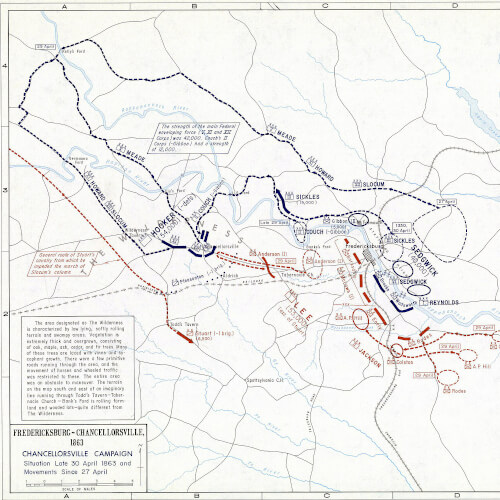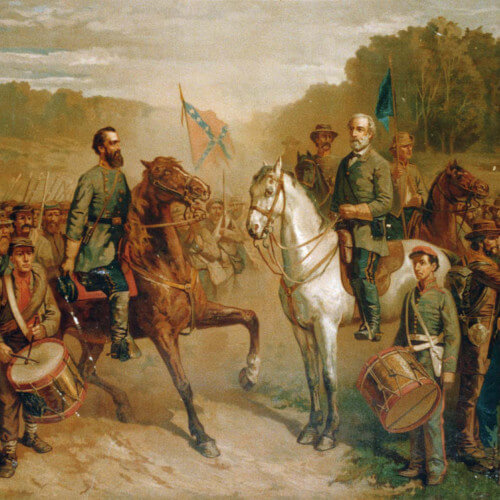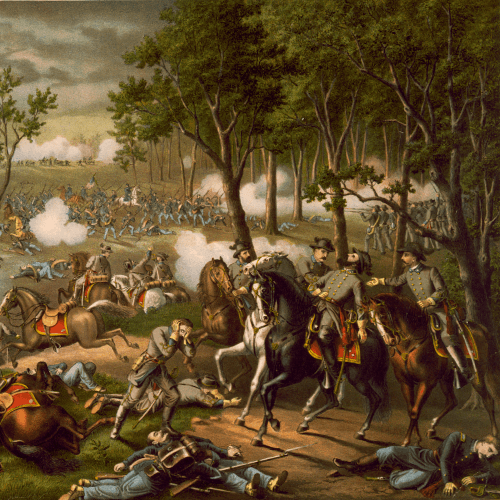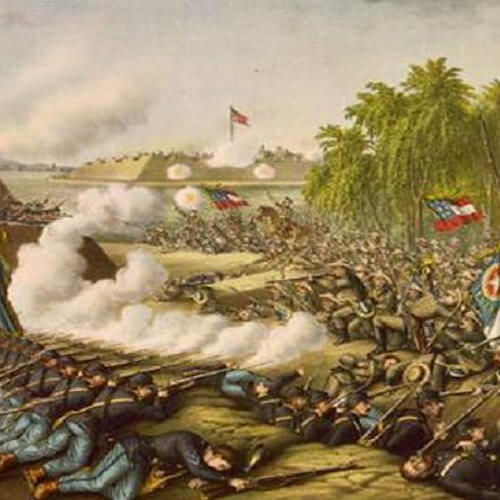Civil War Battles
Exploring some of the major Battles of the Civil WarThe Battle of Chancellorsville
The Battle of Chancellorsville, Virginia was fought from April 30 to May 6, 1863 and was a victory for Robert E. Lee’s Confederate forces over Major General Joseph Hooker’s Army of the Potomac. The battle of famous for being the battle in which Confederate commander General Thomas “Stonewall” Jackson was mortally wounded. This was also Lee’s greatest tactical victory when faced with an opponent who was twice his size, Lee split his army in two and attack Hooker on multiple fronts.
Prelude to Battle
Having suffered a devastating loss at the Battle of Fredericksburg in December 1862, The Union Army replaced General Ambrose Burnside with General Joseph “Fighting Joe” Hooke. In the spring of 1863, Hooker spent time training his Union forces and preparing for the upcoming campaign. Hooker had approximately 115,000 men at his disposal compared to Lee’s 60,000.
On April 27, Hooker places two-thirds of his troops near Fredericksburg to distract the Confederates while he took the other third of his army across the Rappahannock Ricker. His goal was to sneak in behind the Confederate trench and catch them off guard. Lee however, became aware of Hooker’s movements and divided his army. He left Major General Jubal Early in charge of the forces at Fredericksburg while taking the remaining troops to Chancellorsville.
The Battle Begins
On May 1, 1863 the two armies fought in an area near the Wilderness, just west of Chancellorsville. Even though Hooker outnumbered Lee, he ordered his men to fall back and take up a defensive position. This allowed Lee an opportunity to capitalize on Hooker’s decision. Once again Lee split his army and on May 2 sent “Stonewall” Jackson and his 28,0000 troops to attack Union Major General Oliver Howard’s Eleventh Corps right flank. After a nearly 15 mile march, Jackson’s hard fighting troops were able to crush the Union line and force them to fall back.
The Death of Stonewall Jackson
Unfortunately, Lee’s victory would come at a great cost. On the evening of May 2, 1863 Jackson was leading a group of men to scout a forested area. Mistaken as enemy cavalry, a North Carolina regiment fired on Jackson and his group. Jackson was struck by a bullet which shattered his arm above his left shoulder. As the doctors were amputating Jackson’s arm, General J.E.B. Stuart took command of Jackson’s troops.
Jackson died from pneumonia on May 10, 1863. He was 39 years old. The South mourned their war hero, who was buried in Lexington, Virginia.
Confederate Victory
The following day, May 3, Lee continued to attack Hooker who was forced to stay on the defensive. It was then at Lee learned that the Union army had crossed the Rappahnnock and were advancing on his position. Once again Lee splits his army and meets the attack and defeats the Union forces near Salem Church.
On May 5th and 6th, Hooker took his troops and retreated back across the Rappahannock and headed for Washington DC. In the end, the Union army suffered approximately 17,278 casualties and Lee’s army suffred around 12,825. The Battle of Chancellorsville is considered to be Lee’s greatest victory and would inspired him to launch a second invasion of the North.
LEARN MORE
Joseph Hooker
Hooker was born on November 13, 1814, in Massachusetts and like many of his fellow officers was a graduate of West Point and a Mexican War veteran. At the outbreak of the Civil War, Hooker was made brigadier-general of volunteers. In 1862 Hooker commanded the 2nd Division of the III Corps in the Peninsula Campaign and it was during this time he was given the nickname “Fighting Joe” for his fierce leadership in battle. Following the Battle of Fredericksburg in December 1862, Hooker replaced General Burnside as commander of the Army of the Potomac.
In his new role, Hooker improved overall life for the common soldier including food, medical, clothing, and even leave. Unfortunately, Hooker often disagreed with his staff and other officers. Combining this with his massive defeat at Chancellorsville, Hooker resigned his position. Later that summer, Hooker traveled to Tennessee to support General Rosecrans in Chattanooga. In November 1862, he achieved victory at the Battle of Lookout Mountain. Hooker was also successful during the Atlanta Campaign in 1864. In October 1864, he was transferred to command the Northern Department in Cincinnati, Ohio where he remained until the end of the war. He retired from the army in 1868 and died on Halloween in 1879 in Garden City, NY
J.E.B. Stuart
James Ewell Brown (Jeb) Stuart was born on February 6, 1833 in Patrick County, Virginia. After receiving an appointment to the US Military Academy at West Point in 1850, Stuart met Robert E. Lee who became superintendent of the school in 1852. After graduating, Stuart was sent to Texas and was later involved in several conflicts with Native Americans and took part in “Bleeding Kansas.” In 1859, while serving under Lee, Stuart took part in the events that resulted in the capture of John Brown during Brown’s famous raid on Harper’s Ferry.
When the Civil War broke out, Stuart resigned his commission to help defend Virginia. Stuart was promoted to the rank of colonel and placed in command of Thomas “Stonewall” Jackson’s cavalry. Stuart’s first success came after the Battle of Bull Run when he harassed retreating Union troops and captured a large supply train along with numerous prisoners. His flamboyant nature and personality, combined with his dashing uniform that included a gold sash, red-lined cape, and hat that was adorned with an ostrich feather lead to his romanticized image of a cavalier.
In June 1863, Stuart was told to screen the advance of the army as it advanced north. Rather than doing this, Stuart took it upon himself to go on a raiding adventure that took him within sight of Washington, DC but made him arrive late to the Battle of Gettysburg. This delay prevented Lee from having valuable information about Union forces and played a part in the Confederate defeat. On May 11, 1864, Stuart met up against Phil Sheridan’s forces near a place called Yellow Tavern. During the fighting, Stuart was firing at opponents and shouting commands when a bullet pierced his side. He was carried to Richmond where he died on May 12, 1864.
The Red Badge of Courage
The book The Red Badge of Courage, by Stephen Crane, is widely considered to be one of the most realistic portrayals of the Civil War. The story tells of the experiences of 18-year-old Henry Fleming and is based on the Battle of Chancellorsville. Crane spent time interviewing veterans of the battle including members of the 124th New York Volunteers, also known as the Orange Blossoms. Published in 1895, The Red Badge of Courage met with positive reviews despite some objections from some former Union officers. Crane became famous for his book and even served as a war correspondent during the Spanish-American war. While his book remained popular and was even adapted into several films, Crane died of tuberculosis at the age of 28.
One of the Bloodiest Battles
At the end of the Civil War, the Battle of Chancellorsville was the fourth-deadliest battle of the war behind Gettysburg, Chickamauga and the fighting at Spotsylvania Court House. The North lost approximately 17,200 men and the South lost about 13,000 troops. President Lincoln along with many others in the north shocked by the losses. With over 30,000 casualties, Chancellorsville was up to that point the bloodiest battle of the Civil War with most of the casualties happening on May 3rd. Unfortunately, Chancellorsville would lose this distinction when the Battle of Gettysburg occurs a few weeks later.
Learn More
Videos
Vocabulary
Casualties: soldiers who are killed or wounded in battle
Cavalry: soldiers who fought on horseback
Federal – Usually describes people who supported the Union.
Flank – The side of an army or military unit or to go around the end of a line of soldiers
Regiment: The basic unit of the Civil War soldiers that were usually made up of 1,000 to 1,500 men.
Skirmish: A minor fight in a war.




